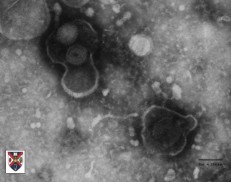| Causes/ Source |
|
Symptoms can be triggered by fever, other viral infections, fatigue, stress, menstruation, ultraviolet energy from the sun, or even the wind.
It is transmitted by direct contact with an active sore or a genital secretion containing viruses. Pregnant women can also infect babies during childbirth. The disease can be transmitted by people who show no symptoms.

![]() Herpes virus
Herpes virus
Copyright 1994 Veterinary Sciences Division
| Effects/ Symptoms |
Symptoms occur two to ten days after exposure, and generally lasts for two to three weeks. The initial outbreak is the worst.
HSV-1 causes cold sores around the mouth. HSV-2 causes the same thing but around the genitals.
The virus produces flu-like symptoms such as muscle aches, swollen glands, fever, and sometimes shooting pain in the legs and abdomen. Symptoms will subside without treatment.
| Possible Solutions/ Treatments/ Prevention |
Once it is inside the body, it's impossible to eradicate. They can survive an entire lifetime in the host, hiding in the nerve endings where the immune system can find it. Sometimes it produces symptoms, but often not..
Some antiviral drugs such as acyclovir can help relieve the severity of the symptoms by reducing the number of outbreaks and the duration of the attacks.
| .. Back to Start |